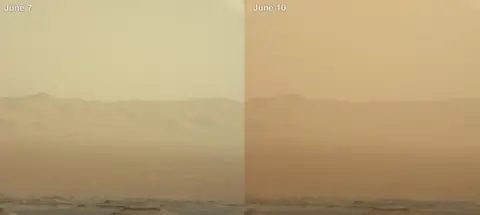Mars Opportunity: Rover 'should ride out storm'
 NASA
NASAThe American space agency says it is concerned but hopeful that its veteran robot rover on Mars can survive a big dust storm on the planet.
The 15-year-old vehicle, known as Opportunity, has gone into an emergency mode because there is not enough sunlight reaching its solar panels to power onboard systems.
All contact was lost at the weekend.
The only function likely running off the batteries currently is a clock.
The expectation is that the robot is using this timepiece to wake itself periodically to check whether skies have cleared.
"It is concerning; this team has a very strong bond with the rover," said John Callas, the Opportunity project manager at Nasa's Jet Propulsion Laboratory.
"We anthropomorphise this rover; we have a tight emotional connection. The analogy I use is it's like having a loved one in the hospital. The doctors are saying you've just got to give it time and she'll wake up. But if it's your 97-year-old grandmother, you're going to be very concerned."
Tough challenge
The plucky robot has already astounded engineers.
 NASA/JPL-CALTECH/MSSS
NASA/JPL-CALTECH/MSSSDesigned to work for just 90 days when it landed back in January 2004, Opportunity has managed to keep on rolling even though it does so now only in reverse and the arm that it uses to put instruments next to rocks to examine them is arthritic.
But the dust storm currently enveloping a quarter of Mars has turned day to night at the rover's equatorial location.
The mission team says the conditions are the worst ever recorded at the surface of the planet.
Opportunity would normally be able to generate over 600 watt-hours of energy per day with its panels at this time of the Martian year - which at its station is entering the northern hemisphere summer.
 NASA/JPL-Caltech/TAMU
NASA/JPL-Caltech/TAMUThe last telemetry down-linked from the rover indicated the rating had fallen to a mere 22 watt-hours.
Opportunity has radioisotope heaters, so its electronics should not experience any damage in the sub-zero conditions. But if the batteries run flat and the master clock also shuts down, then the robot will be relying on a much more complicated mode to reboot it. This is a light-activated trigger that would respond to the brighter Sun that emerged as the storm dissipated.
"We're all pulling for Opportunity," said Jim Watzin, the director of the Mars exploration programme at Nasa. "As you know, it's been a remarkable vehicle. Its longevity has taught us much about operating on the surface of Mars. But regardless of how this turns out, this little rover has proven to be an invaluable investment that has greatly increased our ability to explore the Red Planet."
Record-setter
Opportunity has set records for the most travelled surface vehicle on any planet, trundling some 45km.
Its investigations have identified plenty of evidence that Mars had ancient environments blessed with abundant liquid water - observations that have allowed scientists to build a better picture of the habitability potential of the planet.
 NASA-JPL
NASA-JPLBefore the storm took it offline, Opportunity was exploring "Perseverance Valley" on the west rim of "Endeavour crater".
It was trying to establish whether the valley had been sculpted by water or wind erosion, or both.
Nasa's Curiosity rover, which is half-way around the planet from Opportunity is not affected in the same way by the storm.
It has a big nuclear power source and so is not reliant on solar panels. Curiosity has though been returning pictures of the opacity of the sky, which is helping scientists monitor current conditions and how they might evolve.
Rich Zurek, the chief scientist at JPL's Mars office, said the storm could very well spread to the whole planet, but he did not expect it to last for more than a few weeks.

